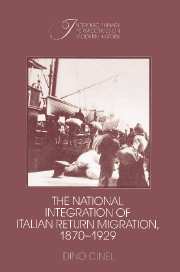Book contents
- Frontmatter
- Contents
- Acknowledgments
- Introduction: Emigration and the process of national integration
- 1 The difficult task of national integration
- 2 A blueprint for change
- 3 The southern ethos
- 4 The national debate
- 5 Return migration
- 6 American remittances
- 7 Investing American savings
- 8 Regional differences
- 9 Return and retirement
- Conclusion: National integration and return migration
- Notes
- Index
7 - Investing American savings
Published online by Cambridge University Press: 03 December 2009
- Frontmatter
- Contents
- Acknowledgments
- Introduction: Emigration and the process of national integration
- 1 The difficult task of national integration
- 2 A blueprint for change
- 3 The southern ethos
- 4 The national debate
- 5 Return migration
- 6 American remittances
- 7 Investing American savings
- 8 Regional differences
- 9 Return and retirement
- Conclusion: National integration and return migration
- Notes
- Index
Summary
Senator Eugenio Faina wrote the final report of the Inchiesta Parliament, 1907–9. The Italian legislature had mandated the Inchiesta as a preliminary step toward a substantial revision and homogenization of land contracts in the south. Since the time of national unification, in fact, a number of economists and legislators had made the argument that any land reform in the south had to start with a revision of land contracts. Of course, southern landowners had strongly opposed the revision and had been able to kill any legislative effort to revise the contracts for over four decades. And even this time they were powerful enough not only to force the government to set aside any plan for the revision of land contracts, but to convince the members of the Inchiesta Faina that no revision was needed. The south was already on its way to substantial changes, landowners argued, thanks to emigration and return migration. The best course of action the government could take, landowners concluded, was to allow return migration and remittances to work their way into southern society.
This chapter discusses the use of remittances by immigrants and returnees. Obviously this is a topic of great interest, which economists and political scientists are still exploring. There is no consensus as to the ultimate economic potential of return migration and remittances. In the specific case of Italian returnees, the profits from emigration were first used to subsidize emigration itself. Perhaps as many as one-third of all Italian emigrants borrowed the money for their first journey.
- Type
- Chapter
- Information
- The National Integration of Italian Return Migration, 1870–1929 , pp. 150 - 176Publisher: Cambridge University PressPrint publication year: 1991

